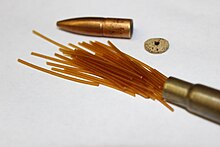
Back Kordiet Afrikaans كوردايت Arabic Cordita Catalan Kordit Czech Cordit Welsh Cordit Danish Kordit German Kordito Esperanto Cordita Spanish Cordite French



Cordite is a family of smokeless propellants developed and produced in Britain since 1889 to replace black powder as a military firearm propellant. Like modern gunpowder, cordite is classified as a low explosive because of its slow burning rates and consequently low brisance [not verified in body]. These produce a subsonic deflagration wave rather than the supersonic detonation wave produced by brisants, or high explosives [not verified in body]. The hot gases produced by burning gunpowder or cordite generate sufficient pressure to propel a bullet or shell to its target, but not so quickly as to routinely destroy the barrel of the gun. [not verified in body]
Cordite was used initially in the .303 British, Mark I and II, standard rifle cartridge between 1891 and 1915.[not verified in body] Shortages of cordite in World War I led to the creation of the "Devil's Porridge" munitions factory (HM Factory, Gretna) on the English–Scottish border, which produced around 800 tonnes of cordite per week. The UK also imported some United States–developed smokeless powders for use in rifle cartridges. Cordite was also used for large weapons, such as tank guns, artillery, and naval guns. It has been used mainly for this purpose since the late 19th century by the UK and British Commonwealth countries. Its use was further developed before World War II, and as 2-and-3-inch-diameter (51 and 76 mm) Unrotated Projectiles for launching anti-aircraft weapons.[1] Small cordite rocket charges were also developed for ejector seats made by the Martin-Baker Company. Cordite was also used in the detonation system of the Little Boy atomic bomb dropped over Hiroshima in August 1945.[2]
The term "cordite" generally disappeared from official publications between the wars. During World War II, double-base propellants were very widely used, and there was some use of triple-base propellants by artillery. Triple-base propellants were used in post-war ammunition designs and remain in production for UK weapons; most double-base propellants left service as World War II stocks were expended after the war. For small arms it has been replaced by other propellants, such as the Improved Military Rifle (IMR) line of extruded powder or the WC844 ball propellant currently in use in the 5.56×45mm NATO.[3] Production ceased in the United Kingdom around the end of the 20th century, with the closure of the last of the World War II cordite factories, ROF Bishopton. Triple-base propellant for UK service (for example, the 105 mm L118 Light Gun) is now manufactured in Germany.
- ^ Brown 1999, Chapter 17
- ^ Coster-Mullen, John (2012). Atom Bombs: The Top Secret Inside Story of Little Boy and Fat Man. Waukesha, Wisconsin: J. Coster-Mullen. OCLC 298514167.
- ^ Watters, Daniel, "The Great Propellant Controversy", The Gun Zone, archived from the original on 22 July 2013, retrieved 30 November 2009